Molson Canadian
GRAND PRIX
Packaged Goods (GOLD)
Client Credits: Molson Coors Canada
David Bigioni, Vice President Marketing, Molson Coors Canada
Jeff Harrop, Senior Marketing Director, Molson Coors Canada
Chris Blackburn, Senior Marketing Manager, Molson Coors Canada
Madeline Burch, Marketing Manager, Commercialization, Molson Coors Canada
Lori Estabrooks, Production Consultant, Molson Coors Canada
Agency Credits: Rethink
Chris Staples, Creative Director Rethink
Ian Grais, Creative Director, Rethink
Aaron Starkman, Creative Director, Rethink
Dre Labre, Creative Director, Rethink
Joel Holtby, Associate Creative Director, Rethink
Mike Dubrick, Associate Creative Director, Rethink
Mark Scott, Associate Creative Director, Rethink
Monica Ghobrial, Producer, Rethink
Clair Galea, Producer, Rethink
Caleb Goodman, Managing Partner, Rethink
Cheryl Munro, Group Account Director, Rethink
Ashley Eaton, Account Director, Rethink
Maxine Thomas, Head of Strategy, Rethink
Darren Yada, National Director of Digital Strategy, Rethink
Jennifer Roberts, Director, Sklar Wilton and Associates
Wes Wolch, Group Strategy Director, MEC
David Stanton, Senior Communications Manager, MEC
Section I — BASIC INFORMATION
| Business Results Period (Consecutive Months): | June 2013-June 2014 |
| Start of Advertising/Communication Effort: | June 2013 |
| Base Period as a Benchmark: | June 2012-June 2013 |
Section II — SITUATION ANALYSIS
a) Overall Assessment
Canada is a nation that appreciates the art of brewing. It’s part of our culture and even part of our identity. Yet the beer category is undergoing significant change. An incredible number of new brands have appeared over the past few years and there has been flux with the category’s segments. Most of the category’s growth has happened in the Value and Super Premium segments. A quick glance at what the market looked like a few years ago and what it looks like today demonstrates the challenge faced by Molson Canadian, which competes in the declining Premium segment.
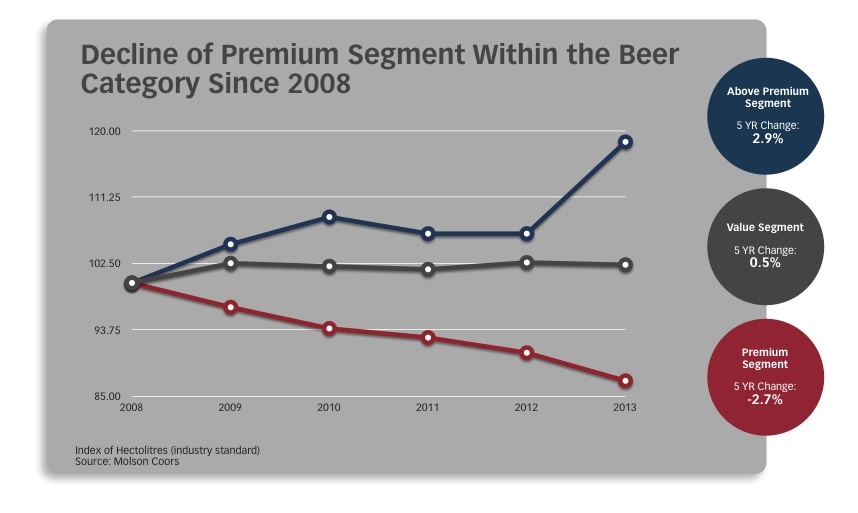
Rapid change isn’t the only challenge: the category as a whole is declining. As a major brand Molson Canadian has been fighting a downward trend. Beer has always been a competitive business but marketplace pressures have only increased. The long-term volume trend is a negative one. In a category where a single share point is worth millions of dollars this is very significant.
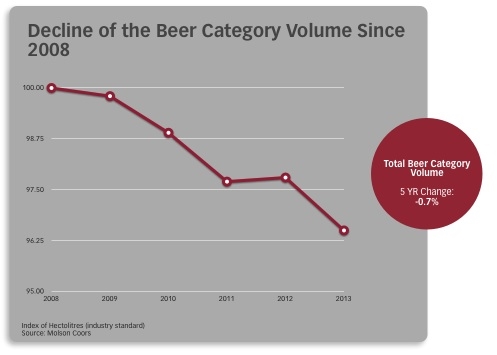
Two other factors have also affected Molson Canadian. First, Millennials (a core target) were born during a time of diminishing birth rates. They’re a smaller group than their parents before them, creating a smaller population base for the brand. Second, a shift in alcohol consumption patterns has compounded everything. Beer was traditionally the primary choice for youth but wine and spirits have increased in popularity with the under 30 crowd. Wine and spirits are perfectly acceptable options for an increasing number of drinkers, as seen below.
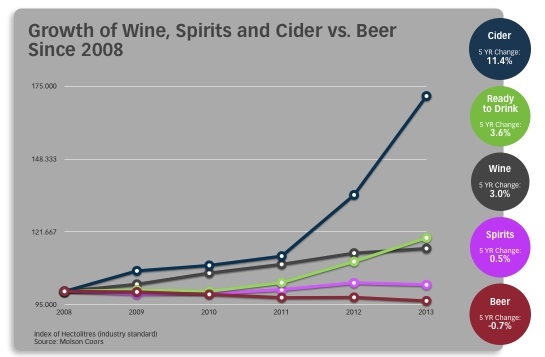
One interesting challenge is unique to Molson Canadian alone: being a cultural icon. This is an aspiration many brands have and attaining this status has incredible benefits but also creates challenges. Knowing which brand equities to protect for the long term, and which to evolve to stay current is a delicate balance. Some assets are specific to a point in time. Others, like the “I AM CANADIAN” tagline, live forever and are part of our national vocabulary.
Molson Canadian is unquestionably an icon in this country. The bottle featured the maple leaf even before it was our flag, and it’s a brand every Canadian knows. On many fronts that’s a plus, but in a category that needs a constant stream of fresh ideas to stay relevant to youth, familiarity can backfire and make the brand seem like it belongs to another, older generation.
b) Resulting Business Objectives
Maintain Share
Our business goal was to hold the brand’s share at 6.4% of the total market. Given the category’s long-term decline simply maintaining share would represent progress for the brand.
Increase profile and relevance with young Millennials
Every mainstream beer brand needs to establish itself with youth, and even though Millennials represent a smaller group than new drinkers in the past, they are still important for the brand. With over 400 brands to choose from getting their attention is an ongoing challenge.
Increase brand momentum
Beer brands need social currency to be successful. Molson Canadian has strong awareness levels but can’t rely on this alone to maintain brand healthy. An important goal was to bring fresh energy to the brand and make it something Canadians – Millennials and beyond – were talking about and watching. We believed we’d be successful if we earned our way onto their Facebook timelines: creating something they would share with their friends on social channels would indicate breakthrough, shared values and cultural impact.
All this had to be accomplished with no “new news”. Beer is a category where trial and share can often be gained (in the short term) through innovations like new flavours and formats. We had none of that to work with: our challenges had to be achieved entirely by enhancing brand equity.
c) Annual Media Budget
Over $5 million
d) Geographic Area
Canada
Section III — STRATEGIC THINKING
a) Analysis and Insight
It’s no a small task to be the brand with the job of capturing our collective Canadian identity. Any brand in any country would feel the weight of this but here in Canada there’s the added challenge of having to reflect a nation that frankly has a hard time defining its core essence.
There are many reasons for this. An inclination to modesty is one. A tendency to poke fun at ourselves is another. Our expression of identity and pride is more quiet and internal, but quiet pride doesn’t lend itself to the kind of communications that drive brand growth.
Knowing this we looked at the opportunity in a different way. We had an early clue in 2012 with a small execution called Canthem, a rendition of O Canada done entirely on Molson Canadian cans, bottles and caps. The small experiment went viral and struck a chord, providing some inspirations for us. Our strategic explorations took a very significant turn when we started to look not at what Canadian identity is, but rather, what triggers it. This line of thinking opened up a fresh take on strategy and has guided the brand and its growth for the past year and a half.
What we found was that some very specific moments transform our quiet, internal expressions of pride into a more extroverted one. We have a clear sense of ourselves and turn up the emotion in some very specific scenarios. These include:
The times when we find ourselves away from home. We’re often most aware of our Canadian identity when we’re on foreign soil and it becomes very clear how lucky we are to be Canadians. Anyone who’s been abroad knows what a Canadian passport means.
When Canada is competing on the world stage. Especially when that competition revolves around our birthright of hockey, you simply can’t expect a Canadian to be quiet when the nation’s attention is focused on what’s happening on the ice.
When, here at home, we all turn our attention to who we are. It’s only one day in the calendar but Canada Day celebrations have become bigger and longer in the last few years. From coast to coast, the country is doing more to celebrate itself and all it stands for.
These moments and events energize the Canadian identity. We believed they could be a fresh springboard for the Molson Canadian brand. No other beer brand in Canada is as uniquely positioned to crystallize the feelings of the nation around these moments.
b) Communication Strategy
Our overall job has been to present Molson Canadian to Millennials, retaining its well-established essence and connection to the Canadian identity, but do this in a way that puts a fresh and current face on the brand. We broke this task down into four pillars.
Create a symbol that could stand for our identity.
Pride is intangible, particularly when it’s pride in something as conceptual as national identity. Arguably the Canadian flag does this but a brand can’t really co-opt that. We believed it would be a very powerful move to develop a tangible symbol of our identity all Canadians would recognize but the brand could call its own. The Beer Fridge became exactly that, and more. Considerable effort went into the engineering needed to create it. It was real and not just a prop, which added to its authenticity and helped it become a social and cultural object.
Associate that new symbol with the product itself.
A beer fridge can contain a lot of Canadian pride, but it serves a practical purpose too: it was designed to contain beer. For its Canada Day appearances the fridge is stocked with maple-leaf bearing cans. During the Olympics it was filled with Victory Bottles, a special run of larger-size bottles to celebrate Canadian victories in Sochi. Canada Olympic House had a special store of them, and a run was done for distribution across the country for the Games. The fridge is the star, but what goes in it also matters.
Leverage the moments that trigger our Canadian identity
The trigger moments that ignite latent feelings were critical for us: they give drinkers permission to express their pride and identity. We timed brand efforts around them. Interestingly, many of the moments also happen to be big volume opportunities.
The launch of the Beer Fridge was deliberately timed to coincide with Canada Day 2013. The symbolism of this would not be lost on people, and even though it was not overtly referenced in the work, it unquestionably made it more powerful.
Evolve the elements and the metrics
Millennials’ media consumption includes traditional media but compared to older targets, elements like social and experiential are very important and persuasive. Accordingly our media plan placed more importance on these elements than in past campaigns.
Similarly metrics have evolved. Rather than measure the campaign traditionally through awareness tracking we believed the more salient metric would be the social impact created by the campaign. We were looking for thing like press coverage, social sharing and engagement, and cultural impact. While we definitely intended to include share metrics for business results, we prioritized public response over traditional tracking for creative evaluation.
Section IV — KEY EXECUTIONAL ELEMENTS
a)Media Used
b)Creative Discussion
The Molson Canadian Beer Fridge is a campaign idea, brand asset and symbol of Canadian pride all rolled into one. It has travelled across the world and across Canada, becoming a phenomenon wherever it goes. The fridge that contains the beer with the country’s name on it has quickly made its mark.
Chapter 1: June 2013 Launch
The campaign debuted in June 2013 with an online video capturing the journey of this special fridge through England, France and Belgium. Everywhere it went it created curiousity and crowds. It’s hard to miss a bright red fridge in a town square, and everyone who saw it tried to open it up. That’s when things got interesting: the only way this fridge opens is with a Canadian passport. It was specially constructed with a device to differentiate between a Canadian passport and one from any other country. When Canadians appeared, everyone was welcome to join in and experience a taste of Canada.
Chapter 2: The Olympic Prelude
The next phase was even more epic. A few months before the Sochi we put out a call through social media for hockey-loving Canadians in far-flung places. With responses from every corner of the planet we ultimately chose Morgan Girard, a hockey lover from Ottawa living in the Gili Islands, in Indonesia.
We lined up two of Morgan’s buddies, provided them with the Beer Fridge (stocked with Olympic Victory Bottles) and transportation to Gili. Their job was to surprise Morgan and deliver the beer he’d want on hand to watch Canada compete at Sochi. Surprise him they did. Gili is a long way from Canada, and the Beer Fridge isn’t easy to move around, but they completed the task, totally surprising Morgan and setting him up for unforgettable Olympic celebrations.
We filmed the entire adventure, debuting a long format version online and in World Juniors Hockey television coverage, just as Olympic buzz was starting. A shortened version followed, directing people online for the complete story. During the Games a second installment featured Morgan doing what Canadians do – getting the locals in on the game of hockey – first in social media and then in broadcast.
Chapter 3: On The Ground In Sochi
In Sochi the Beer Fridge itself became the instant hit of Canada Olympic House and a rallying point for Canada, particularly during hockey games. The brand’s social posts became the most commonly seen pieces in the Facebook feeds of the nation, proving Molson Canadian knows exactly what Canadian pride is and when it comes out to play.
Chapter 4: Canada Day 2014
After a gold medal Olympic run the Beer Fridge came home for its next outing: Canada Day. This time it opened by correctly singing the national anthem. We filmed Canadians singing, humming and occasionally stumbling their way through O Canada. The prize for those who got it right, beyond pride, was an open fridge and beer to share with their friends.
c)Media Discussion
We approached media in the broadest sense, including PR, sponsorship, experiential and social as well traditional media. Three considerations determined the media strategy for the Beer Fridge.
1. Develop a campaign structure that maximizes impact and credibility with a Millennial audience.
The media plan was crafted to build momentum across paid, earned and owned media. Our goal of connecting with a Millennial target made this essential as social media creates currency and credibility for them. They still see and respond to traditional media, but to reinforce Molson Canadian’s presence with them and update brand perceptions the social environment was a priority. Each wave launched in social media, and leveraged mobile, paid search and digital display to extend its presence.
2. Time it to build momentum for the trigger moments.
The maiden voyage of the Beer Fridge was in the days leading up to Canada Day 2013. The prelude to the Olympics began during World Juniors, which kicked off a period of intense Olympic anticipation. By the time the Games began involvement was already high. International media response to the Fridge at Canada Olympic House created a second wave of interest. And in the week prior to Canada Day 2014 the latest version of the Beer Fridge was seeded to ensure a July 1st peak.
3. Create Pacing/Flighting
Although we worked with individual trigger moments the cumulative effect over the year built a bigger sense of brand presence and relevance among Millennials. Each chapter in the odyssey added freshness and amplified it into an even bigger phenomenon.
Section V — BUSINESS RESULTS
a) Sales/Share Results
Molson Canadian has once again earned the right to unite us in the moments we’re most proud to be Canadian. The Beer Fridge campaign delivered demonstrable growth for the brand and has defied the long-term category trend of decline.
Cultural metrics
We set ourselves a goal of creating cultural impact and we achieved it. The cachet Beer Fridge created for itself and the brand is remarkable.
It has gone viral three separate times since launch, generating 6.5 million views (2.7 million views at launch, 1.9 million for Olympics, and 1.9 for the latest Canada Day version). The launch phase was awarded Best in Show at the 2014 Marketing Awards and a Bronze Lion at Cannes.
It has generated $160 million in PR value globally, over $50 million of that in Canada – three times the brand’s media budget.
During the Sochi Games it wasn’t just Canadians who noticed. Every international media outlet at the Games dropped by to see the Beer Fridge. Buzzfeed recognized it as one of the top 10 reasons Canada “won” the Olympics.
The three friends at the heart of the GIli Island chapter became media figures during the Games, creating exactly the type of social traction and authenticity we felt would get the brand on our target’s timeline.
Molson constantly fields requests from Canadians coast to coast wanting the Beer Fridge in their homes, their cottages and at their events. Requests have come from Ireland, L.A., Nashville and Belgium. The Canadian Embassy in Paris asked for it, our Ambassador in Washington wanted it for Canada Day celebrations. This is exactly the cultural impact we hoped to achieve and a sign the campaign has tapped into very powerful emotions in Canadians, no matter where they are.
Social Metrics
Social engagement metrics demonstrate the campaign’s impact in the medium that really matters to Millennials. They are an indication of the target not just seeing the Beer Fridge activity but engaging with it.
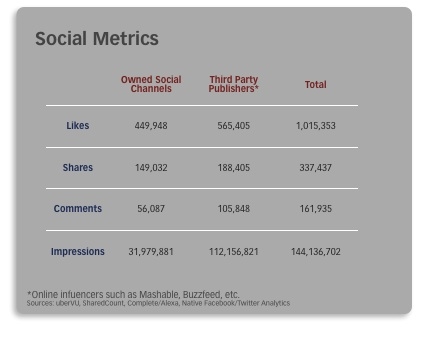
In a category that continues to experience decline Molson Canadian share has grown since the launch of Beer Fridge. Even in the most challenging segment of the category it is gaining share. The campaign has reversed a solid five-year downward trend.
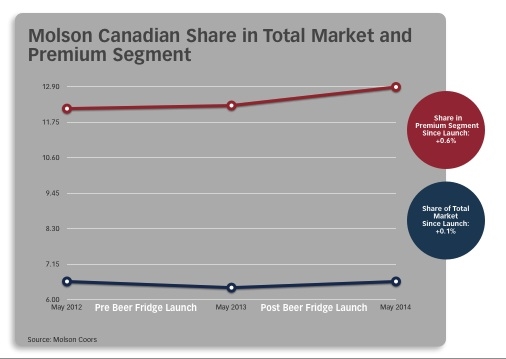
Share growth from June 2013 to June 2014 is even more impressive in contrast to the downward performance of the Premium segment in the same time period specifically. The Premium segment continued to decline, but Molson Canadian grew.
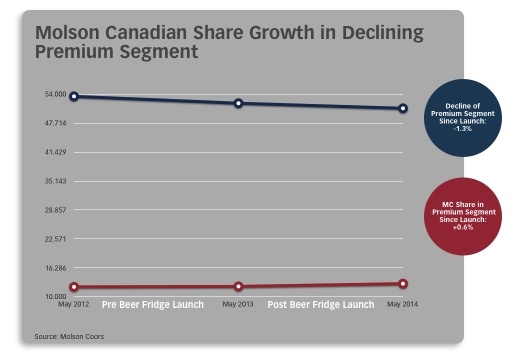
Over Delivery Versus Plan
The brand’s business plan called for holding share steady at 6.4% of the total market. Share came in at 6.5%. In this category 0.1% is a significant number. It represents an extra 26,389 Hectolitres. In more familiar terms this figure is the equivalent of an addition 7.6 million bottles of beer, or one extra Molson Canadian for one-third of all drinkers in Canada.
Incremental Revenue
The period since Beer Fridge launched has generated over $6 million in incremental revenue for the business.
b) Consumption/ Usage Results
c) Other Pertinent Results
d) Return on Investment
Section VI — CAUSE & EFFECT BETWEEN ADVERTISING AND RESULTS
a)General Discussion
Other factors that could affect results have remained constant since previous years.
b)Excluding Other Factors
Spending Levels:
The brand’s budget for Beer Fridge activity was consistent with the previous three years of support.
Pricing:
Pricing is consistent with other premium lagers, and other than Limited Time Offers (which all brands do) it has remained constant.
Distribution Changes:
Molson Canadian’s distribution levels have not changed. The brand has nation-wide distribution.
Unusual Promotional Activity:
Promotional activity was consistent for the brand and the category.
Other Potential Causes:
There were no product innovations or changes during the campaign.
The investment against Beer Fridge represented the majority of the brand’s meida budget. Support for music and hockey, the brand’s other activity streams, represented a smaller portion of the investment.
Related to hockey, the NHL lockout from September 2012 to January 2013 did not result in share decline. Share increase due to the Beer Fridge was not a result of comparisons to depressed share the year earlier.
On a final note, using share and not volume as our measure of success neutralizes the impact of variables that drive increases or decreases in total category volume. Factors like weather (good or bad) affect all brands, and therefore category volume, equally. Hard-won share gains demonstrate Molson Canadian has gained ground on its competitors, and are the true indication the Beer Fridge campaign has succeeded.